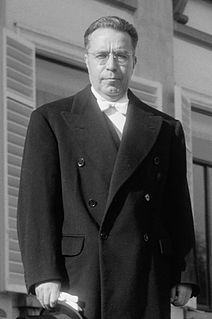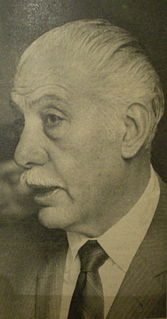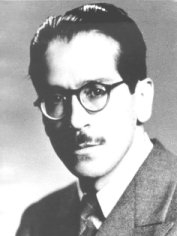
Hugo Banzer Suárez was a Bolivian politician, military general and President of Bolivia. He held the Bolivian presidency twice: from 1971 to 1978, as a dictator; and then again from 1997 to 2001, as constitutional President.

The Revolutionary Nationalist Movement is a Bolivian political party and the leading force behind the Bolivian National Revolution. It influenced much of the country's history since 1941.

Ángel Víctor Paz Estenssoro was a Bolivian politician who served as President of Bolivia from 1952 to 1956, 1960 to 1964 and 1985 to 1989. He ran for president eight times and was victorious in 1951, 1960, 1964 and 1985. His 1951 victory was annulled by a military junta led by Hugo Ballivián, and his 1964 victory was interrupted by the 1964 Bolivian coup d'état.

Jaime Paz Zamora was President of Bolivia from August 6, 1989 to August 6, 1993. He also served as Vice-President between 1982 and 1984.
The Revolutionary Left Movement - New Majority is a social democratic political party in Bolivia. It was a member of the Socialist International.

Juan Lechín Oquendo was a labor-union leader and head of the Federation of Bolivian Mine Workers (FSTMB) from 1944 to 1987 and the Bolivian Workers' Union (COB) from 1952 to 1987. He also served as Vice President of Bolivia between 1960 and 1964.

The Revolutionary Party of the Nationalist Left was a left-wing political party in Bolivia. It was founded in 1963 by the labor leader Juan Lechín Oquendo and by Mario Torres Calleja and Edwin Moller in lesser roles. The PRIN seceded from the Revolutionary Nationalist Movement (MNR) in protest against Víctor Paz Estenssoro's decision to seek a third elected term as president in 1964, rather than permit then Vice-President Juan Lechín to have the MNR's presidential nomination.

Luis Adolfo Siles Salinas was the Constitutional President of Bolivia for a period of five months between April and September 1969.
David Padilla Arancibia was a military general and de facto president of Bolivia. He ruled his country from November 1978 to August 1979.
General Guido Vildoso Calderón is a former officer in the Military of Bolivia and de facto President of Bolivia in 1982.
The Democratic and Popular Union (1977–84) was a Bolivian umbrella political alliance uniting various smaller left-wing parties. It was formed in 1977 by former president Hernán Siles Zuazo and consisted chiefly of Siles' Movimiento Nationalista Revolutionario de Izquierda, a spin-off of the Moviminento Nacionalista Revolucionario, and Jaime Paz Zamora's Movimiento de Izquierda Revolucionaria. The coalition became extremely popular with Bolivian voters in the late 1970s, due to fatigue with the military dictatorships that for the most controlled the country since 1964.

The history of Bolivia from 1964 to 1982 is a time of periodic instability under various military dictators. On November 4, 1964 power passed from the elected leader of the Bolivian National Revolution, Víctor Paz Estenssoro to a military junta under vice-president General René Barrientos. Barrientos was elected president in 1966, but died accidentally in a helicopter crash in 1969, leading to a coup in September 1969 by General Ovando, who was overthrown in October 1970 by General Rogelio Miranda who was overthrown a couple of days later by General J.J.Torres, who in turn was overthrown on August 1971 by Hugo Banzer Suárez. Banzer ruled for seven years, initially from 1971 to 1974 with the support of Estenssoro's Nationalist Revolutionary Movement. In 1974, impatient with schisms in the party, he replaced civilians with members of the armed forces and suspended political activities. The economy grew impressively during Banzer's presidency, but demands for greater political freedom undercut his support. He called elections in 1978 and Bolivia once again plunged into turmoil. Juan Pereda ruled for only four months in 1978, but his ascent to the presidency marked the beginning of an even more unstable period in Bolivian history, with nine civilian and military presidents in little over four years (1978–1982). 1982 marked the return to a democratically elected government, with Guido Vildoso as president.

General elections were held in Bolivia on 9 July 1978. The elections were the first held since 1966, with several military coups taking place during the late 1960s and early 1970s. Although Juan Pereda of the Nationalist Union of the People won the presidential elections, more votes were cast than there were registered voters. After examining a number of allegations of fraud and other irregularities, the Electoral Court decided to annul the results on 20 July. The following day, Pereda was installed as President following a military coup. Pereda himself was overthrown by yet another military coup in November, which saw General David Padilla assume the presidency. Fresh elections were held the following year, with Padilla transferring power to his democratically elected successor, Wálter Guevara.

General elections were held in Bolivia on 1 July 1979. As no candidate in the presidential elections received a majority of the vote, the National Congress was required to elect a President. However, the Congress failed to elect a candidate after three ballots, and instead selected Senate leader Wálter Guevara to serve as Interim President for a year on 8 August. Guevara was later overthrown by a military coup led by Alberto Natusch on 31 October. Fresh elections were held in June 1980.
The Authentic Revolutionary Party was a political party in Bolivia.
The Leftwing Revolutionary Nationalist Movement was a centre-left political party in Bolivia.
The Socialist Party was a left-wing (socialist) political party in Bolivia.
The Offensive of the Democratic Left was a small reform-oriented centrist political party in Bolivia.
The National Commission of Inquiry Into Disappearances was a truth commission in Bolivia that lasted from 1982 to 1984. It was the first truth and reconciliation commission in Latin America. After a period of political instability in the country and a series of military coups and corrupt governments and dictatorships, the newly appointed president Hernán Siles Zuazo hoped to restore the country to democracy when he came to power in October 1982. Siles Zuazo established the National Commission of Inquiry Into Disappearances to look into suspicious disappearances that occurred between 1967 and 1982, and hired 8 commissioners to research and investigate. The commission was forced to disband after less than 2 years of work due to lack of financial and political support from the government, as well as the commission's limited mandate, which only allowed investigations into death or disappearance and not into other crimes against humanity. Although the commission disbanded, 56 officials from past governments were put on trial in the "Trials of Responsibility", including dictator Luis García Meza Tejada. The Trials of Responsibility lasted from 1984 to 1993, during which 48 people were convicted.












